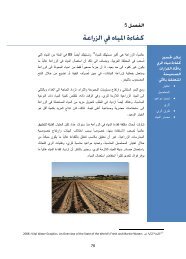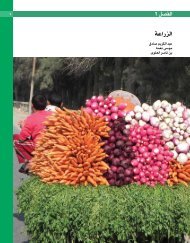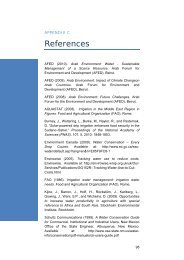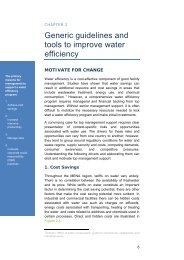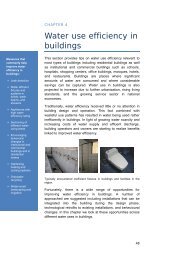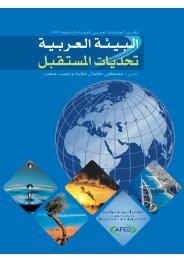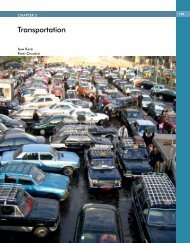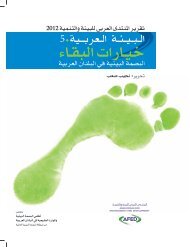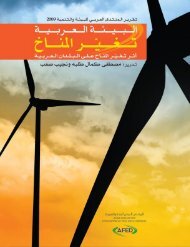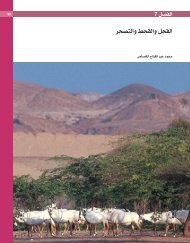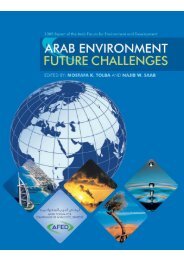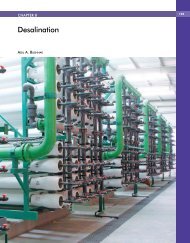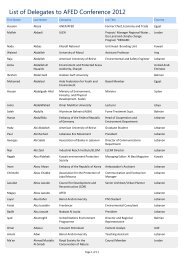Impact of Climate Change on Arab Countries - (IPCC) - Working ...
Impact of Climate Change on Arab Countries - (IPCC) - Working ...
Impact of Climate Change on Arab Countries - (IPCC) - Working ...
Create successful ePaper yourself
Turn your PDF publications into a flip-book with our unique Google optimized e-Paper software.
ARAB ENVIRONMENT: CLIMATE CHANGE 27<br />
underway, but mostly they are in the early stages<br />
<str<strong>on</strong>g>of</str<strong>on</strong>g> development in many countries.<br />
III. MEASURE OF CARBON SEQUESTRA-<br />
TION AND STORAGE<br />
Mitigati<strong>on</strong> <str<strong>on</strong>g>of</str<strong>on</strong>g> GHG means implementing policies<br />
and measures to reduce anthropogenic GHG<br />
emissi<strong>on</strong>s from sources such as power plants,<br />
industrial facilities and the transport sector, as<br />
well as to enhance natural GHG sinks such as<br />
forests, land use change and carb<strong>on</strong> capture and<br />
storage (CCS). This secti<strong>on</strong> discusses enhancements<br />
<str<strong>on</strong>g>of</str<strong>on</strong>g> carb<strong>on</strong> sinks through afforestati<strong>on</strong>s and<br />
CO 2 capture & storage.<br />
Land use change: Afforestati<strong>on</strong><br />
There is a widespread recogniti<strong>on</strong> <str<strong>on</strong>g>of</str<strong>on</strong>g> the potential<br />
<str<strong>on</strong>g>of</str<strong>on</strong>g> forests and land-use changes for <str<strong>on</strong>g>of</str<strong>on</strong>g>fsetting<br />
emissi<strong>on</strong>s <str<strong>on</strong>g>of</str<strong>on</strong>g> GHGs. Measures proposed in<br />
nati<strong>on</strong>al communicati<strong>on</strong>s included promoting<br />
programmes <str<strong>on</strong>g>of</str<strong>on</strong>g> c<strong>on</strong>servati<strong>on</strong>, regenerati<strong>on</strong>, reforestati<strong>on</strong>,<br />
and afforestati<strong>on</strong>.<br />
In Sudan, two main groups <str<strong>on</strong>g>of</str<strong>on</strong>g> mitigati<strong>on</strong> opti<strong>on</strong>s<br />
were c<strong>on</strong>sidered for increasing carb<strong>on</strong> sequestrati<strong>on</strong><br />
and storage. The first group represents<br />
afforestati<strong>on</strong> and rehabilitati<strong>on</strong> opti<strong>on</strong>s. These<br />
opti<strong>on</strong>s refer to the afforestati<strong>on</strong> and rehabilitati<strong>on</strong><br />
<str<strong>on</strong>g>of</str<strong>on</strong>g> wastelands, together with afforestati<strong>on</strong> <str<strong>on</strong>g>of</str<strong>on</strong>g><br />
10% <str<strong>on</strong>g>of</str<strong>on</strong>g> the rain fed land and 5% <str<strong>on</strong>g>of</str<strong>on</strong>g> the irrigated<br />
agricultural land. The sec<strong>on</strong>d group represents<br />
management opti<strong>on</strong>s, which involve a natural<br />
resource management approach based <strong>on</strong> the<br />
c<strong>on</strong>servati<strong>on</strong> and rehabilitati<strong>on</strong> <str<strong>on</strong>g>of</str<strong>on</strong>g> degraded<br />
forests and rangelands. Reforestati<strong>on</strong> and biomass<br />
c<strong>on</strong>servati<strong>on</strong> projects are also key elements<br />
in Djibouti’s proposed programme <str<strong>on</strong>g>of</str<strong>on</strong>g> acti<strong>on</strong>.<br />
Tunisia reported <strong>on</strong> a c<strong>on</strong>certed approach with<br />
neighbouring countries, and with the internati<strong>on</strong>al<br />
community for the implementati<strong>on</strong> <str<strong>on</strong>g>of</str<strong>on</strong>g> a<br />
program aimed at combating desertificati<strong>on</strong>.<br />
Similar projects were also reported in<br />
Mauritania, Djibouti, and Morocco.<br />
A promising CDM afforestati<strong>on</strong> project is currently<br />
being proposed by the Egyptian<br />
Envir<strong>on</strong>mental Affairs Agency. The Greater<br />
Cairo Ring Road Afforestati<strong>on</strong> project will help<br />
improve the air quality <str<strong>on</strong>g>of</str<strong>on</strong>g> Cairo. The forest that<br />
will be planted will be irrigated by treated agricultural<br />
drainage water and will absorb about<br />
100,000 t<strong>on</strong>s <str<strong>on</strong>g>of</str<strong>on</strong>g> CO 2eq annually, helping to <str<strong>on</strong>g>of</str<strong>on</strong>g>fset<br />
the carb<strong>on</strong> emissi<strong>on</strong>s from vehicles, industry<br />
and power plants. The project is currently under<br />
development. In additi<strong>on</strong>, Japan Bank for<br />
Internati<strong>on</strong>al Cooperati<strong>on</strong> (JBIC) c<strong>on</strong>ducted a<br />
preliminary study <strong>on</strong> the Egyptian Bi<str<strong>on</strong>g>of</str<strong>on</strong>g>uel<br />
Industry Development in June, 2007. Jatropha<br />
test cultivati<strong>on</strong> was started in 2003 as a part <str<strong>on</strong>g>of</str<strong>on</strong>g><br />
Egypt’s afforestati<strong>on</strong> program. The Egyptian<br />
Jatropha yield turned out to be the highest producti<strong>on</strong><br />
level compared to the Asian and African<br />
n<strong>on</strong>-irrigated cultivati<strong>on</strong>. Although the primary<br />
purposes <str<strong>on</strong>g>of</str<strong>on</strong>g> the Egyptian Jatropha model are<br />
anti-desertificati<strong>on</strong> and beneficial use <str<strong>on</strong>g>of</str<strong>on</strong>g> treated<br />
wastewater, the high producti<strong>on</strong> results caught<br />
the attenti<strong>on</strong> <str<strong>on</strong>g>of</str<strong>on</strong>g> private bi<str<strong>on</strong>g>of</str<strong>on</strong>g>uel producers. Under<br />
that study, JBIC proposed an integrated strategic<br />
plan to realize the new bi<str<strong>on</strong>g>of</str<strong>on</strong>g>uel industry with a<br />
“Public Private Partnership” (JDI, 2007).<br />
Another remarkable afforestati<strong>on</strong> experience is in<br />
the UAE. According to the Envir<strong>on</strong>mental Agency<br />
- Abu Dhabi, “Over the last few decades, over 120<br />
milli<strong>on</strong> trees have been planted, as well as 25 milli<strong>on</strong><br />
date palms. Over 92,000 hectares have been<br />
planted with forest trees. These are now helping to<br />
reverse the process <str<strong>on</strong>g>of</str<strong>on</strong>g> desertificati<strong>on</strong> and to stabilize<br />
the sand dunes that <strong>on</strong>ce moved inexorably<br />
across the land. They also provide attractive new<br />
habitats for wildlife, with many species <str<strong>on</strong>g>of</str<strong>on</strong>g> animals<br />
and birds increasing rapidly in numbers as they<br />
col<strong>on</strong>ise the new areas <str<strong>on</strong>g>of</str<strong>on</strong>g> vegetati<strong>on</strong>”<br />
(Envir<strong>on</strong>mental Agency Abu Dhabi, 2006).<br />
Carb<strong>on</strong> Capture and Storage (CCS)<br />
CO 2 capture & storage (CCS) is a process comprised<br />
<str<strong>on</strong>g>of</str<strong>on</strong>g> three steps. The first is CO 2 capture<br />
from CO 2 point sources such as power plants,<br />
industrial facilities, and natural gas wells with high<br />
CO 2 c<strong>on</strong>tent emissi<strong>on</strong>s. The sec<strong>on</strong>d step is transportati<strong>on</strong><br />
via pipelines to the storage site; and the<br />
third step is geological storage in deep geological<br />
formati<strong>on</strong>s including saline formati<strong>on</strong>s, depleted<br />
oil/gas fields, coal seams, and enhanced oil or gas<br />
recovery sites. In the combusti<strong>on</strong> processes, CO 2<br />
can be captured either in pre-combusti<strong>on</strong> mode<br />
by treatment <str<strong>on</strong>g>of</str<strong>on</strong>g> fossil fuels or in post-combusti<strong>on</strong><br />
mode by treatment <str<strong>on</strong>g>of</str<strong>on</strong>g> the flue gases. Due to<br />
ec<strong>on</strong>omies <str<strong>on</strong>g>of</str<strong>on</strong>g> scale, large point sources <str<strong>on</strong>g>of</str<strong>on</strong>g> CO 2<br />
emissi<strong>on</strong>s have the highest potential <str<strong>on</strong>g>of</str<strong>on</strong>g> CO 2 capture.<br />
These include large industries such as oil and



